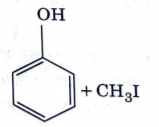Anisole on cleavage with HI gives:




To solve the question regarding the cleavage of anisole (methoxybenzene) with HI, we can follow these steps:
Step 1: Identify the structure of anisole
Anisole is known as methoxybenzene, and its structure can be represented as follows:
- It consists of a benzene ring (C6H5) attached to a methoxy group (-OCH3).
Step 2: Understand the reaction with HI
When anisole reacts with hydrogen iodide (HI), it can be broken down into its components. HI can dissociate into H⁺ and I⁻ ions. The methoxy group (-OCH3) is electron-rich due to the lone pair of electrons on the oxygen atom.
Step 3: Protonation of the methoxy group
The lone pair of electrons on the oxygen atom of the methoxy group can attack the H⁺ ion from HI, leading to the formation of a protonated methoxy group:
- This results in the formation of a positively charged intermediate.
Step 4: Cleavage of the bond
Now, we need to determine which bond will break. The bond between the oxygen and the carbon (C-O bond) is weaker than the bond between the carbon and the benzene ring (C-C bond) due to resonance stabilization in the benzene ring. Therefore, the C-O bond will break.
Step 5: Formation of products
Upon cleavage, we will obtain two products:
1. Phenol (C6H5OH): This is formed from the benzene ring after the methoxy group is removed.
2. Methyl iodide (CH3I): This is formed from the methoxy group after it reacts with the iodide ion (I⁻).
Conclusion
The products formed when anisole is cleaved with HI are phenol and methyl iodide.
Final Answer
The correct answer is: Phenol and Methyl Iodide.
---
Anisole is known as methoxybenzene, and its structure can be represented as follows:
- It consists of a benzene ring (C6H5) attached to a methoxy group (-OCH3).
When anisole reacts with hydrogen iodide (HI), it can be broken down into its components. HI can dissociate into H⁺ and I⁻ ions. The methoxy group (-OCH3) is electron-rich due to the lone pair of electrons on the oxygen atom.
The lone pair of electrons on the oxygen atom of the methoxy group can attack the H⁺ ion from HI, leading to the formation of a protonated methoxy group:
- This results in the formation of a positively charged intermediate.
Now, we need to determine which bond will break. The bond between the oxygen and the carbon (C-O bond) is weaker than the bond between the carbon and the benzene ring (C-C bond) due to resonance stabilization in the benzene ring. Therefore, the C-O bond will break.
Upon cleavage, we will obtain two products:
1. Phenol (C6H5OH): This is formed from the benzene ring after the methoxy group is removed.
2. Methyl iodide (CH3I): This is formed from the methoxy group after it reacts with the iodide ion (I⁻).
The products formed when anisole is cleaved with HI are phenol and methyl iodide.
The correct answer is: Phenol and Methyl Iodide.
Similar Questions
Knowledge Check
Phenyl methyl ether (on anisole) reacts with HI to give phenol and methyl iodide and not iodobenzene and methyl alcohol. Justify .
AI− ion prefers to combie with the smaller group in order to minimise steric hindrance group in order to minimise steric hindranceBI− ion is not ractive towards benzneCphenol is formed as a result of hydrolyis of iodobenzeneDmehtyl alcohol fromed durin reaction racts wit I− to from methyl iodile .
Assertion : Tert- butyl methyl ether on cleavage with HI at 373 K gives tert-bytyl iodide and methano.
Reason : The reaction occurs by SN1 mechanism.
View SolutionAnisole on reaction with HI forms
View SolutionGlucose on prolonged heating with HI gives
View SolutionWhen anisole is heated with HI , the product is :
View SolutionIn insect egg, cleavage is
View SolutionDimethyl ether when heated with exces HI gives :
View SolutionDimethyl ether when heated with exces HI gives :
View Solution
